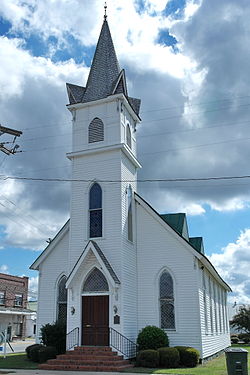LaGrange Presbyterian Church | |
 | |
| Location | 201 S. Caswell Street, La Grange, North Carolina |
|---|---|
| Coordinates | 35°18′17″N77°47′21″W / 35.30472°N 77.78917°W |
| Area | less than one acre |
| Built | 1892 |
| Architectural style | Gothic Revival |
| NRHP reference No. | 86001646 [1] |
| Added to NRHP | August 14, 1986 |
The La Grange Presbyterian Church, also known as the La Grange Rotary Club, is a historic Presbyterian church building located on Caswell Street in La Grange, Lenoir County, North Carolina. It was constructed in 1892, and is a Gothic Revival style frame building. [2]
It was added to the National Register of Historic Places in August 1986. [1] It is located in the La Grange Historic District.



